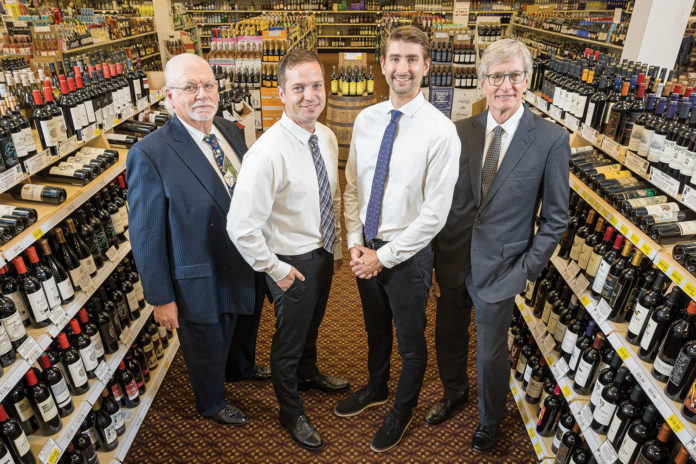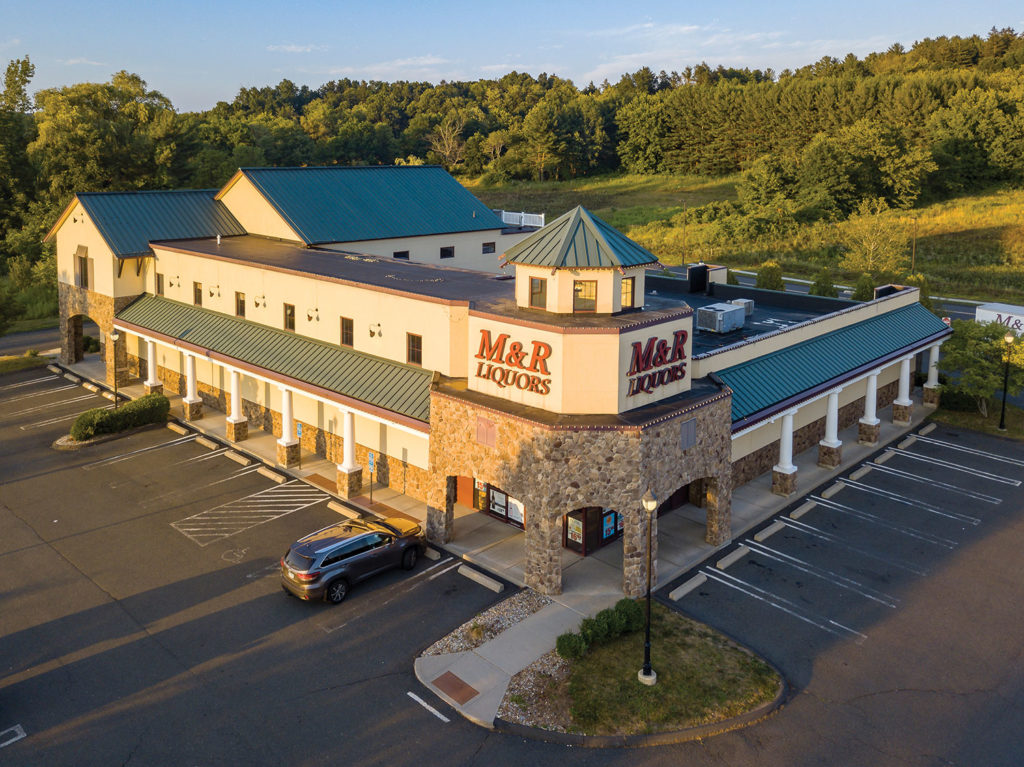
“I always say this about my time in business, and I’ve been active for 53 years: For the first ten years I worked for my father, and for the next ten I worked with my father, and then he retired to Florida, and he’d come up here once a month for ‘pigeon trips’, where he’d crap all over the way that my brother and I were running the business.”
Gary Rounesville laughs as he retells this story from his spacious office atop the Manchester, CT location of M & R Liquors. Founded in nearby Glastonbury in 1952 by “M” Marrion Rounesville and “R” Roy Rounesville, M & R grew into 14 stores by the 1970s. Around the same time, control of the family business passed down to Gary and his brother Neal. Both run operations to this day. Their sons Ian and Kyle, respectively, joined the company full time in 2009, representing the third generation.
Today, M & R consists of six stores that encircle Connecticut’s capital city of Hartford. Three locations operate on the east side of the Connecticut River Ñ which flows down the middle of the state Ñ with another three on the west side. Gary is General Manager of the east side of the business, while Neal is GM of the west. The stores average between 7,000 and 12,000 square feet.
Altogether the company routinely receives national accolades, including membership in the Wine and Spirits Guild of America, and inclusion in the Beverage Dynamics magazine Top 100 Retailers rankings.
What makes M & R stand out? The business enjors a reputation for maintaining and training staff at the management level, so that customers can enjoy personal relationships with these professionals that last decades. The stores also excel in other forms of customer service, as well as selection, organization and location.
“My father understood the business model, understood that liquor stores have to be on the righthand side of the road for people coming home from work,” says Gary. “Location, location, location. That’s the biggest thing.”
Despite what Gary’s father might say when acting like a pigeon on a statue, the second and third generations at M & R have continued to build out the business in a manner that intelligently grows for the future.

Advantage in Management
M & R takes loyalty very seriously with management. The company goes through great lengths to keep and educate these important employees. Some have been with M & R for more than 30 years, while many can count at least a decade.
One reason why is the high level of education and training available for staff. “Something I started was taking our employees on trips,” Gary says. “We organize trips to Argentina and Chili for wine, Puerto Rico for rum, Mexico for tequila. Our staff go to every wine country in Europe, every AVA in California.”
“This gets staff to experience the products where they are made,” he adds. “Most stores you go to, if you ask about a product, the manager will tell you, ‘I tried it and I liked it’. In our store, we say, ‘When I was at the winery with the winemaker, I tried it and I liked it’. That makes a lot of difference to the customer.”
Agreeing with Gary is his son Ian: “When you can say you were at the chateau with the winemaker, it’s an easier sell, because it’s easier to sell the store than the wine.”
M & R floats between 18 and 21 managers across its six stores. “Last time I counted we had seven with 30 years with us,” Gary says. “The youngest manager is now going on five years.”
Managers at M & R have four-day workweeks, with 11-hour shifts. Two managers retired in 2021, and now work two days a week.
Maintaining longevity in management helps build meaningful relationships with customers. “People will come in and ask our managers where they traveled last,” Gary says. “Customers follow our managers. They want to know all about where they’ve gone, what they’ve tasted. That allows us to focus customers on new things.”
Trips also include traveling to Louisville for single barrel whiskey picks.
“My son Ian has been leading those trips for the last three to for years,” Gary says. “We send them down there and let them pick the barrels. That’s been a big thing, recently.”
Single Barrel Picks
Connecticut has become somewhat of a hotbed for single barrel picks in the northeast. The small state boasts a handful of retailers known throughout New England for their barrel programs, plus one of the largest regional Facebook groups for whiskey fans.
This thriving culture of brown spirits includes M & R. “We did our first pick eight years ago, which was Russel’s Reserve,” Ian recalls. “We did some Woodford Reserves early on, as well.”
Today, the picking program continues strong, with recent bottles from Starlight and Yellowstone. M & R has consistently brought in single barrels that their customers have enjoyed. As with retailers everywhere, this has helped fill a gap in their whiskey selection as the category explodes in popularity.
“Early on, a lot of our customers saw the writing on the wall, that they would no longer be able to get the highly sought after, allocated whiskeys that everybody wants,” Ian says. “The best strategy now to get great single barrels of that quality is to find picks that are really good.”
“Customers come to trust your picks after a while after they have a few good ones from you,” he continues. “Also, it’s not that difficult. You’re not always walking around the rickhouses and picking out barrels. They’ll have samples ready for you and you get to pick one. Obviously, the preferred picking method is onsite. It’s hard to replicate that with a sample mailed to you, versus being in a rickhouse with Jimmy Russell, and he’s telling you why the barrel is good, and you can relate that to a customer.”
Stylistically, Ian sees two primary strategies for making selections.
“One is you try to exaggerate the flavors that a whiskey already has,” he says. “Like when we do a Woodford Reserve Double Oaked, we try to go over the top with the oak and chocolate dessert profile.”
“The other thing you can do is try to pick something different than the whiskey’s typical profile,” he adds, “like with the Maker’s Mark picks with different stave finishes. You’re looking for something that customers haven’t had in another Maker’s Mark release.”
More advice Ian has for stores considering single barrel picks: “We try to be selective with our picks. I see some stores, I walk in, and I know they say ‘yes’ to every barrel that comes to them. I see stuff on their shelf that I said ‘no’ to.”
“Because of our size it’s easier for us to move through barrels,” he adds. “For someone who’s a single store or only a couple, they really have to be selective with what they say ‘yes’ to if only because of the quantity of bottles they have to sell through. It’s a lot. When you get twelve to twenty cases from a barrel, that can take a long time to sell through if the barrel is not awesome.”
Picks from different distilleries also allow M & R staff to expand customers palates, educating consumers about all the excellent alternatives to the typical “unicorns” and “tater” bottles.
“There’s a lot of great whiskey out there other than the super-trendy, allocated stuff,” Ian says. “I really appreciate having those conversations with customers about all the bourbons, ryes and other whiskeys.”
Recognizing Alcohol Trends
As for trends beyond our modern golden age for American whiskey, Gary sees a fading consumer interest in merlot and pinot noir wines.
So what’s next to capture the attention of wine drinkers?
“Syrah, maybe,” Gary says. “You have to gamble with these things, trying to predict ahead of time where the trends are going next. Are wine drinkers now looking for something more substantial? Then perhaps they’re heading to syrah. Our bet’s on that.”
“We’re always watching the customer,” he adds. “If I see that every week we go through a case of a grenache wine from Spain, then I’m looking to add other Spanish grenaches in addition to that brand that’s moving. You have to have your finger on the pulse when you’re buying. The buying is almost as important as the selling.”
M & R keeps managers current on what’s trending and what’s next through biweekly meetings. They will taste 20 wines with staff to makes sure everyone is up to date with what’s going on.
Hints towards the future of the industry can also come from businesses beyond traditional beverage alcohol retail.
“Something my dad always told me was to pay attention to what the grocery stores are doing,” Gary says. “The grocery chains have all sorts of money to spend on R&D. With that in mind, when we’re looking ten years down the road, I could see us getting into self-checkout, with things being the way they are.”
Gary imagines a setup with one employee overseeing several self-serve checkouts. Among the most important tasks for that staffer would be checking everyone’s IDs.
Intelligent Layout
Another reason that customers come back to M & R is because the store has organized its SKUs on the sales floor in an intelligent, helpful manner.
“One thing we did very early on was we varietalized our wine,” Gary explains.
Rather than grouping wines by region first, the store focuses on the grape. Chardonnays are all together, from California to Europe and other regions worldwide.
This promotes experimentation across varietals, while making it easier for customers to find what they want.
“I still go to some stores where they organize all their wines by California or Europe, and then I have to walk across the entire store to find a Chardonnay from Chili,” Gary says.
This strategy extends elsewhere in the stores. M & R separates the vodka section into two groups: straight and flavored.
What’s Next?
As with retailers nationwide, M & R is dealing with a business environment that has changed so much so many years now into the Covid-19 pandemic.
“Due to Covid, we had enormous sales early on in the pandemic,” Gary recalls. “But now we’re seeing that back off because bars and restaurants have opened again and people are going out.”
Internally, the transition from second to third generation of Rounesville leadership at M & R has already begun. Like his own father enjoying the sunnier climate of Florida in his later years, Gary has begun spending months at a time in Costa Rica. This has opened up opportunities for his son Ian to take on more responsibility. Same for Neal’s son Kyle
Until that day of retirement, Gary continues to enjoy working in the world of beverage alcohol retail.
“The nicest part of our industry is that it’s a hospitality industry,” he says. “What’s not to love? We get to travel to all these different wineries and distilleries who want to show off their properties to us and entertain us. It’s a wonderful trade to be in.”
One challenge for independent retailers like M & R remains the ever-present threat of Big Box retail chains.
“We have Big Box stores all around us,” Gary says, “but I think that only makes us better. It makes us concentrate more on our business.”
Kyle Swartz is editor of Beverage Dynamics magazine. Reach him at kswartz@epgacceleration.com. Read his recent piece, Turn Your Customers into Social Media Influencers.



